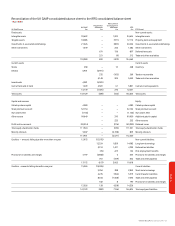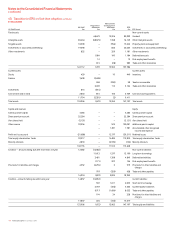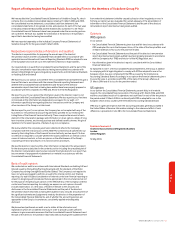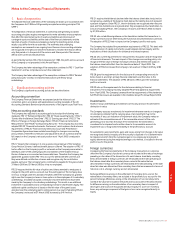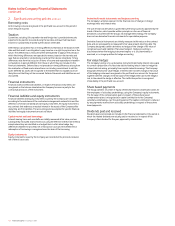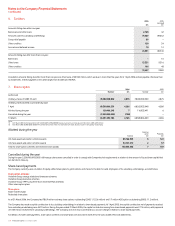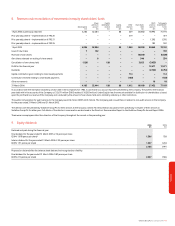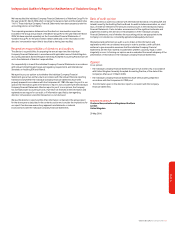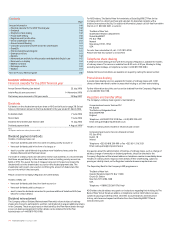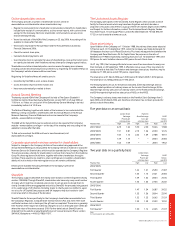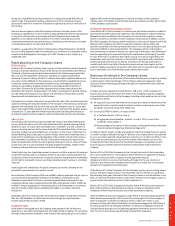Vodafone 2006 Annual Report Download - page 136
Download and view the complete annual report
Please find page 136 of the 2006 Vodafone annual report below. You can navigate through the pages in the report by either clicking on the pages listed below, or by using the keyword search tool below to find specific information within the annual report.134 Vodafone Group Plc Annual Report 2006
Notes to the Company Financial Statements
continued
2. Significant accounting policies continued
Borrowing costs
All borrowing costs are recognised in the profit and loss account in the period in
which they are incurred.
Taxation
Current tax, including UK corporation tax and foreign tax, is provided at amounts
expected to be paid (or recovered) using the tax rates and laws that have been
enacted or substantively enacted by the balance sheet date.
Deferred tax is provided in full on timing differences that exist at the balance sheet
date and that result in an obligation to pay more tax, or a right to pay less tax in the
future. The deferred tax is measured at the rate expected to apply in the periods in
which the timing differences are expected to reverse, based on the tax rates and
laws that are enacted or substantively enacted at the balance sheet date. Timing
differences arise from the inclusion of items of income and expenditure in taxation
computations in periods different from those in which they are included in the
financial statements. Deferred tax is not provided on timing differences arising from
the revaluation of fixed assets where there is no binding commitment to sell the
asset. Deferred tax assets are recognised to the extent that it is regarded as more
likely than not that they will be recovered. Deferred tax assets and liabilities are not
discounted.
Financial instruments
Financial assets and financial liabilities, in respect of financial instruments, are
recognised on the balance sheet when the Company becomes a party to the
contractual provisions of the instrument.
Financial liabilities and equity instruments
Financial liabilities and equity instruments issued by the Company are classified
according to the substance of the contractual arrangements entered into and the
definitions of a financial liability and an equity instrument. An equity instrument is
any contract that evidences a residual interest in the assets of the Company after
deducting all of its liabilities. The accounting policies adopted for specific financial
liabilities and equity instruments are set out below.
Capital market and bank borrowings
Interest-bearing loans and overdrafts are initially measured at fair value, and are
subsequently measured at amortised cost, using the effective interest rate method,
except where they are identified as a hedged item in a fair value hedge. Any
difference between the proceeds net of transaction costs and the settlement or
redemption of borrowings is recognised over the term of the borrowing.
Equity instruments
Equity instruments issued by the Company are recorded at the proceeds received,
net of direct issue costs.
Derivative financial instruments and hedge accounting
The Company’s activities expose it to the financial risks of changes in foreign
exchange rates and interest rates.
The use of financial derivatives is governed by the Group’s policies approved by the
board of directors, which provide written principles on the use of financial
derivatives consistent with the Group’s risk management strategy. The Company
does not use derivative financial instruments for speculative purposes.
Derivative financial instruments are initially measured at fair value on the contract
date, and are subsequently re-measured to fair value at each reporting date. The
Company designates certain derivatives as hedges of the change of fair value of
recognised assets and liabilities (“fair value hedges”). Hedge accounting is
discontinued when the hedging instrument expires or is sold, terminated, or
exercised, or no longer qualifies for hedge accounting.
Fair value hedges
The Company’s policy is to use derivative instruments (primarily interest rate swaps)
to convert a proportion of its fixed rate debt to floating rates in order to hedge the
interest rate risk arising, principally, from capital market borrowings. The Company
designates these as fair value hedges of interest rate risk with changes in fair value
of the hedging instrument recognised in the profit and loss account for the period
together with the changes in the fair value of the hedged item due to the hedged
risk, to the extent the hedge is effective. The ineffective portion is recognised
immediately in the profit and loss account.
Share based payments
The Group operates a number of equity settled share based compensation plans for
the employees of subsidiary undertakings, using the Company’s equity instruments.
The fair value of the compensation given in respect of these share based
compensation plans is recognised as a capital contribution to the Company’s
subsidiary undertakings, over the vesting period. The capital contribution is reduced
by any payments received from subsidiary undertakings in respect of these share
based payments.
Dividends paid and received
Dividends paid and received are included in the financial statements in the period in
which the related dividends are actually paid or received or, in respect of the
Company’s final dividend for the year, approved by shareholders.







